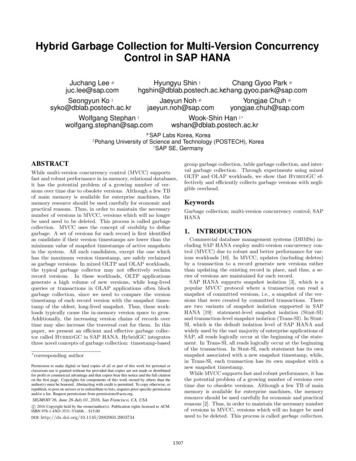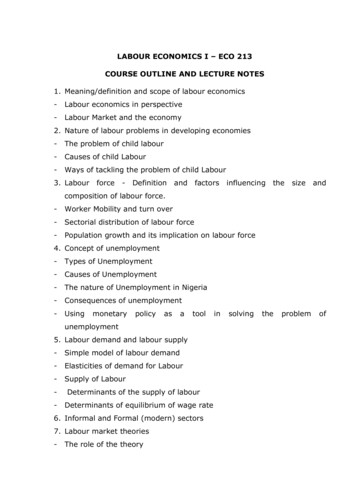
Transcription
LABOUR MARKET SNAPSHOTJUNE 2021Labour Market Information
This project is funded in part by the Government of Canada's Sectoral InitiativesProgram (SIP).For more information about this briefing or Trucking HR Canada, please contactus:(613) en referring to the information presented in this report, please cite Trucking HRCanada, or use the following reference:Trucking HR Canada. (2021). Labour Market Snapshot: June 2021. Ottawa: TruckingHR Canada.We also want to recognize our partner The Canadian Trucking Alliance (CTA).1Labour Market Information
Labour market information (LMI) is actionable intelligence pertaining to thesupply and demand of labour. It puts raw data into context and facilitatesbetter, evidence-based decisions by employers, workers, job seekers,policymakers, educators, career practitioners, academics, students,parents, and more.LMI at Trucking HR Canada not only includes publicly available sources,including Statistics Canada’s census and other labour force surveys, butalso qualitative research and quantitative data directly from employers to fillin the gaps that are lacking.2Labour Market Information
Researchers around the world will be assessing the impact of the COVID-19 pandemicon social and economic well-being for years to come. For our part, Trucking HRCanada has been monitoring the performance of the trucking and logistics sector andclosely following the effect the pandemic has had on our labour market.In April and May 2020, following the declaration of the global pandemic by the WorldHealth Organization, the Canadian economy experienced an unprecedented decreasein economic activity, with real GDP declining by almost 18% between February andApril with the onset of the first wave. This drop in GDP translated into historically highjob losses across all sectors of the economy: 2.9 million people lost their jobs and thecountry reported record high unemployment levels, with the unemployment ratenearing 14% in May of 2020. As we experienced multiple pandemic waves,unemployment in the Canadian economy remained high, peaking again in January2021 at close to 10% in response to the second wave.Among Transport Truck Drivers, employment also declined significantly during thepandemic’s first wave, with the occupation shedding just over 28,000 jobs in April of2020 and unemployment rates soaring to 14.3% in May. However, the occupationrecovered quickly as the first wave subsided, adding back over 74,800 employed truckdrivers between May and August with the unemployment rate dropping to an averageof 4.3% over this period (well below the national average). With the onset of thesecond wave, truck driver employment began to decline again in November 2020, withthe loss of some 25,000 jobs. Interestingly, the second wave was not accompanied bythe same spike in unemployment as the first – the unemployment rate averaged 5.5%during the months of November, December and January, only slightly higher than the5.1% observed during the same period in 2019-20 (pre-COVID).Source: Trucking HR Canada, Statistics Canada, Labour force survey, custom data request, May 20213Labour Market Information
It is important to note, however, that this labour market data is not adjusted to accountfor the seasonal variations normally observed in the Canadian trucking and logisticssector. Truck driver employment shifts significantly from month to month based on theirsupport of industries whose activity fluctuates from season to season. To betterunderstand the direct impact of the pandemic on employment of drivers, Trucking HRCanada, with support from the Conference Board of Canada, has developed seasonallyadjusted employment data for the Truck Driver occupation.Source: Trucking HR Canada, Conference Board of Canada, Statistics Canada, Labour force survey, customdata request, May 20214Labour Market Information
The seasonally adjusted employment data shows that while the first wave had adampening effect on the employment of truck drivers, more than half of thereduction observed in April and May are attributable to normal seasonal fluctuations.Furthermore, the rapid recovery following the first wave was led by seasonal gainsin truck driver employment.Nearly all the fluctuation in employment during the second wave is attributed toannual seasonal factors. According to data from the May 2021 Labour ForceSurvey, employment of truck drivers has rebounded to pre-COVID levels with theseasonally adjusted employment of drivers higher than the occupation’s 10-yearaverage by about 11,100 jobs. As a result, although the pandemic had an initialimpact on employment during the first wave, employment has rebounded and thesecond and third wave has not resulted in a similar drop in employment.Finally, based on the most recently available vacancy data, there were some 15,995vacant truck driver positions in the last quarter of 2020, with a vacancy rate of 5%.In comparison, the vacancy rate across all occupations in Canada was 2.7%. Thisindicates the occupation has already returned to similar shortages that wereexperienced before the pandemic.The data is clear – the pressure and stress on trucking and logistics’ companies’recruitment, training, and retention initiatives is not going away anytime soon.And even more importantly – this will put added pressure and stress on Canada’seconomic recovery.Trucking and logistics supports key economic sectors from retail/wholesale trade toconstruction, agriculture, forestry and mining, and more.One fact remains: the longer it takes to better address driver shortages – the longerit will take for full economic recovery.Labour Market Information5
Looking for more:Trucking HR Canada’s labour market information initiative has the following reportsavailable:1)2)3)4)5)6)Assessing the impact of Covid-19 on Trucking and Logistics EmploymentCovid-19 Briefing Employer survey resultsCovid-19 Impressions of the Trucking and Logistics Industry reportCovid-19 and Truck Driver Employment in Canada reportLabour Market Snapshot: September 2020Labour Market Snapshot: November 2020Want to stay informed? Subscribe to our newsletter HERE.6Labour Market Information
8Labour Market Information
Labour Market Information Labour market information (LMI) is actionable intelligence pertaining to the supply and demand of labour. It puts raw data into context and facilitates better, evidence-based decisions by employers, workers, job seekers, policymakers, educators, career practitioners, academics, students, parents, and more.










